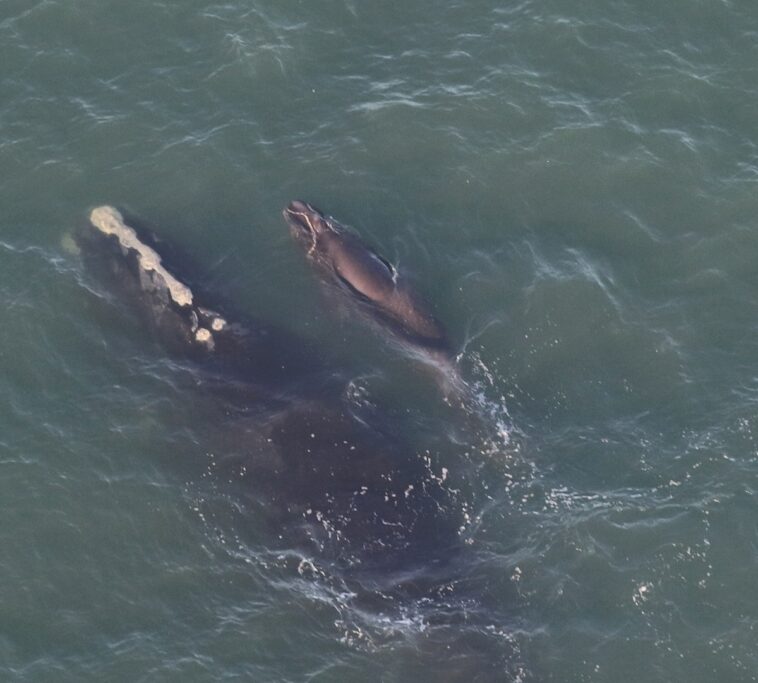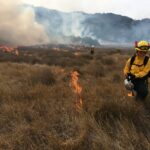The latest on North Atlantic right whales adds a calf to the official count for this calving season and relays some sobering headlines about entanglements.
First, the good: Right whale catalog No. 4540 was seen with a calf about 6 nautical miles off the coast of southern Virginia Dec. 18. This is 4540’s first known calf. Interestingly, the new mom is the daughter of Juno, catalog No. 1612 and best known for losing her calf to a vessel strike in the Southeast last winter.
The calf of 4540 is the third documented this winter.
And now the bad. Two days before that new calf was photographed, an aerial survey team from the Clearwater Marine Aquarium Research Institute spotted a right whale entangled in commercial fishing gear about 43 nautical miles off North Carolina’s Outer Banks. The whale, identified as No. 5132, was born in 2021. He was last seen in October in the Bay of Fundy, gear-free.
Entangled whale No. 5132 off Corolla Beach, N.C., Dec. 16, 2024. (Clearwater Marine Aquarium Research Institute/NOAA permit 26919)
NOAA biologists consider the entanglement as a “serious injury” case, meaning that right whale 5132 will likely die from it. Since Dec. 16, teams including Georgia DNR staff have been on alert in case the whale is seen again and an entanglement response is possible.
Quick note about the photo: Identifying marks on the fishing gear have been blurred to protect the privacy of individuals. NOAA is working to determine the gear’s origin.
Unfortunately, No. 5132 was the third entangled whale in about a week. North Atlantic right whales 5110, a juvenile male, and the adult female No. 4120 were seen trailing thick fishing line off the coast of Massachusetts Dec. 9. Read more about these cases on NOAA’s website, including how entanglement in commercial fishing gear threatens the survival of this endangered whale species.
To close on a brighter note, four whales — a 12-year-old female (No. 4308 or Freckles), the 6-year-old female Coral (No. 4980) and adult males Popcorn (No. 4194) and No. 3950 (no nickname) — were seen 26 miles off Isle of Palms, S.C., on Dec. 18.
Sorry, no calves in the group. At least not yet.
WHAT YOU CAN DO
When boating off the Southeast Atlantic’s coast from November to April, follow guidelines for Navigating in Right Whale Waters (here’s a flyer that sums it up for recreational boaters):
- Slow down when boating where right whales are present. Use the Whale Alert app to know if whales are possibly in the area.
- Keep watch. Look for dark objects at the surface, large splashes, fluke swirls (slick spots on the surface) and recurring whitewater that could be made by a whale’s tail, and the “V” shaped spout whales create when they breathe.
- Report sightings by calling 877-WHALE-HELP (877-942-5343) or by hailing the U.S. Coast Guard on marine VHF channel 16.
- If you spot a whale, slow down further, operate at slow speed or put your engine in neutral. Assess the scene and slowly leave the area while keeping watch—other whales could be nearby. Stay at least 500 yards from any right whale you see (it’s the law) and never pursue or follow one.
Video or images of right whales used by media or other outlets must include the following: Taken by Georgia DNR under NOAA permit 26919. It is illegal to approach right whales in U.S. waters without a research permit. Other vessels, aircraft and drones must maintain a distance of at least 500 yards from these endangered whales. Researchers shown have the training and permits required to approach right whales safely and legally.
Right whale research led by HDR Inc. is funded by U.S. Fleet Forces Command and managed by Naval Facilities Engineering Systems Command Atlantic under the U.S. Navy’s Marine Species Monitoring program. The Clearwater Marine Aquarium Research Institute surveys that reported the entangled whale and the other four adult whales off the Carolinas are funded by the U.S. Army Corps of Engineers.




GIPHY App Key not set. Please check settings